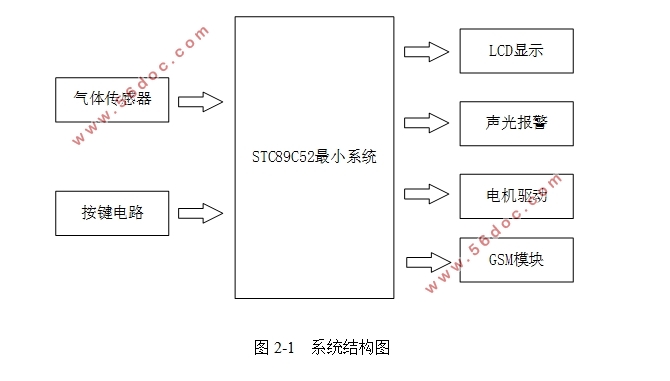家用燃气报警系统设计
来源:56doc.com 资料编号:5D26883 资料等级:★★★★★ %E8%B5%84%E6%96%99%E7%BC%96%E5%8F%B7%EF%BC%9A5D26883
资料以网页介绍的为准,下载后不会有水印.资料仅供学习参考之用. 密 保 惠 帮助
资料介绍
家用燃气报警系统设计(论文11000字)
摘要:本论文设计完成了一款用于预防由于燃气泄漏而引发灾害的报警系统。文中介绍了燃气报警系统的设计的意义及发展现状。系统设计选用STC89C52单片机作为主要控制芯片,配合气体传感器完成燃气浓度的采集,将气体浓度信号并转化成电压信号后,再转化为数字量送入单片机,单片机将数据处理后送给液晶显示屏显示浓度值。当浓度超过安全值时发生声光报警,驱动电机转动开窗通风,并通过GSM模块向用户发送报警信息;当气体浓度降低到安全阈值后,解除报警,从而实现对家用燃气安全的实施监控。因此对于家庭用户来说安装家用燃气报警装置可以实时检测厨房等场所的燃气浓度,当燃气浓度过高时发出警报提醒用户及时采取措施,以此来最大程度上避免火灾、爆炸等悲剧的发生。
关键词:气体传感器;单片机;燃气报警;GSM模块
The Design of Domestic Gas Alarm System
Abstract:This paper has designed an alarm system to prevent disasters caused by gas leaks. What′s more, the paper introduces the significance and development status of the design of gas alarm system. Thesystem design selects STC89C52 microcomputer to be the main control chipin this thesis, and completes the gas concentration collection with the gas sensor. After converting the gas concentration signal into a voltage signal, it is converted into a digital quantity and sent to the microcomputer. Then display the density value on the LCD.When the concentration exceeds the safe value, an audible and visual alarm occurs, the drive motor rotates to open the window and ventilates, and sends an alarm message to the user through the GSM module; when the gas concentration decreases to a safety threshold, the alarm is cancelled, realizing the monitoring of the implementation of household gas safety.Therefore, for household users, installing a household gas alarm device can detect the gas concentration in a kitchen and the like in real time, and when the gas concentration is too high, an alarm is issued to prompt the user to take measures in time to minimize the occurrence of tragedies such as fire and explosion.
Key words:gas sensor;MCU;gas alarm;GSM module


目录
1. 引言 1
1.1 燃气报警研究背景及意义 1
1.2国内外研究现状 1
1.3 课题研究的主要内容 2
2.系统方案总体设计 2
2.1设计思路 2
2.2总体方案设计 3
3.家用燃气报警系统的硬件设计 3
3.1单片机最小系统 3
3.1.1单片机的选择 3
3.1.2时钟电路 4
3.1.3复位电路 4
3.2气体传感器模块 4
3.2.1气体传感器 5
3.2.2模数转换 6
3.3 LCD显示模块 7
3.4声光报警模块 7
3.5电机驱动模块 8
3.6 GSM模块 9
3.7按键模块 11
4.软件设计 11
4.1气体浓度检测程序 11
4.2LCD浓度显示程序 13
4.3声光报警程序 13
4.4电机驱动程序 14
4.5 GSM发送短信程序 15
5.系统调试与实现 16
5.1仿真实现 16
5.1.1原理图设计 16
5.1.2 仿真结果 17
5.2实物设计及实现 19
6.总结与展望 22
参考文献 22
致谢 24
|





